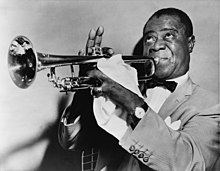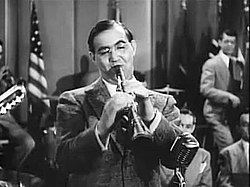| Jazz by decade |
|---|
Swing jazz emerged as a dominant form in American music, in which some virtuoso soloists became as famous as the band leaders. Key figures in developing the "big" jazz band included bandleaders and arrangers Count Basie, Cab Calloway, Jimmy and Tommy Dorsey, Duke Ellington, Benny Goodman, Fletcher Henderson, Earl Hines, Glenn Miller, and Artie Shaw. Duke Ellington and his band members composed numerous swing era hits that have become standards: "It Don't Mean a Thing (If It Ain't Got That Swing)" (1932), "Sophisticated Lady" (1933) and "Caravan" (1936), among others. Other influential bandleaders of this period were Benny Goodman and Count Basie.

Swing was also dance music. It was broadcast on the radio 'live' nightly across America for many years especially by Hines and his Grand Terrace Cafe Orchestra broadcasting coast-to-coast from Chicago, well placed for 'live' time-zones. Although it was a collective sound, swing also offered individual musicians a chance to 'solo' and improvise melodic, thematic solos which could at times be very complex and 'important' music. Over time, social structures regarding racial segregation began to relax in America: white bandleaders began to recruit black musicians and black bandleaders. In the mid-1930s, Benny Goodman hired pianist Teddy Wilson, vibraphonist Lionel Hampton, and guitarist Charlie Christian to join small groups. Kansas City Jazz in the 1930s as exemplified by tenor saxophonist Lester Young marked the transition from big bands to the bebop influence of the 1940s.
Outside of the United States the beginnings of a distinct European style of jazz emerged in France with the Quintette du Hot Club de France which began in 1934. Belgian guitar virtuoso Django Reinhardt popularised gypsy jazz, a mix of 1930s American swing, French dance hall "musette" and Eastern European folk with a languid, seductive feel. The main instruments are steel stringed guitar, violin, and double bass. Solos pass from one player to another as the guitar and bass play the role of the rhythm section. Some music researchers hold that it was Philadelphia's Eddie Lang (guitar) and Joe Venuti (violin) who pioneered the gypsy jazz form,[1] which was brought to France after they had been heard live or on Okeh Records in the late 1920s.[2]
Broadway theatre contributed some of the most popular standards of the 1930s, including George and Ira Gershwin's "Summertime" (1935), Richard Rodgers and Lorenz Hart's "My Funny Valentine" (1937) and Jerome Kern and Oscar Hammerstein II's "All the Things You Are" (1939). These songs still rank among the most recorded standards.[3] Johnny Green's "Body and Soul" was introduced in Broadway and became a hit after Coleman Hawkins's 1939 recording. It is the most recorded jazz standard of all time. It is the bread and butter.[4]




